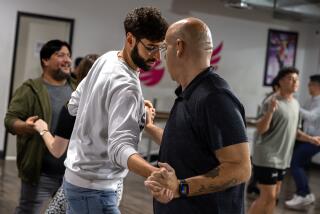Emotionally resonant work from Sean Curran
- Share via
There’s no fresher, more invigorating new American dance now than the choreography of Sean Curran, an artist with a background in Irish step dance, postmodern experiment and Broadway hoofing--but no clear allegiance to anything but his restless imagination.
Curran’s nine-dancer company came to the Irvine Barclay Theatre on Friday with three recent, plotless group works steeped in nostalgia.
“From the Ether, With Instinct,” for example, collected artifacts of pop dance from the 1960s on up and reassembled them in witty collages set to recordings by the Scottish band Young Marble Giants.
Curran whomped an imaginary guitar and danced a robotic go-go solo, while the rest of the company playfully wagged their heads, shook that thing, walked like an Egyptian, twisted the night away and paired off for swing dancing.
Binding all these familiar moves: the dancers repeatedly pulling out the sides of their loose, bright pants and smiling as if posing for snapshots.
But besides being an album of signature dance tropes through the decades, “From the Ether” provided opportunities for sophisticated choreographic expression--most notably, perhaps, in a fleet, technically complex duet near the end for Amy Brous and Tony Guglietti.
This kind of breathless, emotionally responsive and sharply focused dancing dominated the rest of the program and, right now, may represent the essence of Curran’s modern dance style.
In “Sonata (We Are What We Were),” he used that style to create another tribute to the past, but not a specific reflection of it. A circle of tiny wooden chairs and circular folk-dance formations evoked a sense of community rooted in tradition, but the dancing used its folkloric skip steps and somber Janacek score with great freedom.
Semaphoric windmill or propeller arms emerged as the key motif, but like the other structural building blocks here, they seemed to melt at the end, becoming an attempt to embrace or hold onto the air, maybe even to stop time and make a moment of loving togetherness last forever.
In the unison passages that dominated the work, one dancer’s unexpected jump or a sudden lift would break the pattern, reminding you of the individual personalities within the group--and sharpening your perceptions.
Emphasizing this individuality, Curran’s “Six Laments” set weighty solos and duets in front of three large portraits by Kieran McGonnell on Venetian blinds, portraits that could vanish with the pull of a cord.
Accompanied by a mournful commissioned score by Seamus Egan, the opening solo by Heather Waldon-Arnold defined the hopeless reaching and sinking patterns that others would develop and embellish in their segments.
For all its sincere, shared sense of loss, the work had mysteries galore: the identity of those people in the portraits, the presence of a dancer (David Zurak) who never danced and, above all, the cause or inspiration for this movement elegy. (No, it isn’t a response to Sept. 11; it dates from 1999.) Donna Scro Gentile was pregnant when it was choreographed and on Friday depicted pregnancy in her solo, suggesting that Curran intended to document something specific and personal, rather than grief in the abstract.
Similarly, the oddities in his own solo--searching for something, trying to turn but always falling--played like living memories. But of what? In some ways, “Six Laments” seemed the simplest piece on the Curran program. However all those unanswered questions--the feeling that this dance work had life or meaning beyond what we saw on the stage--gave it a strange resonance.
By keeping his secrets, Curran reinforced the sense of isolation evident in the piece from the first tableau. Like Zurak, we could only watch from a distance, not know what Curran knew, not feel what he felt. Grief may be a universal emotion, but it strikes and shapes each of us differently. Out of that difference, “Six Laments” made rich, persuasive dance art.
Besides the dancers mentioned, the company included Nora Brickman, Peter Kalivas and Kevin Scarpin.
*
(BEGIN TEXT OF INFOBOX)
The highlights
The Eclectic Orange Festival continues through Nov. 10. This week’s highlights include:
Tuesday: The Kronos Quartet performs selections from “Nuevo,” their sometimes quirky but revelatory recording of music by Mexican composers.
Wednesday: Anoushka Shankar (yes, her father is Ravi) performs a sitar recital.
Thursday: John Williams and Friends perform “Music of Africa.”
Friday: The West Coast premiere of Osvaldo Golijov’s “La pasion segun San Marcos” (also Saturday).
For information: (949) 553-2422.
More to Read
The biggest entertainment stories
Get our big stories about Hollywood, film, television, music, arts, culture and more right in your inbox as soon as they publish.
You may occasionally receive promotional content from the Los Angeles Times.










